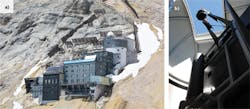Atmospheric Lidar: Raman lidar using industrial excimer laser measures high-altitude water vapor
The distribution of atmospheric water vapor plays a key role in climate and meteorological events—this distribution is highly inhomogeneous and dynamic. To enable improved understanding and modeling of both short-term weather events and long-term climate changes, researchers desire measurements of water vapor at climate-relevant altitudes: the troposphere (0–12 km altitude) and into the lower stratosphere.
Over time, scientists have developed several spectroscopically based methods to perform remote measurements using terrestrial systems at high-altitude weather stations, as well as airborne systems using airplanes or balloons. Several such systems have been developed and optimized by Thomas Trickl and Hannes Vogelmann from the Karlsruhe Institute of Technology (KIT; Garmisch Partenkirchen, Germany) on Mount Zugspitze (see figure), Germany’s highest (2964 m) peak. Both a differential absorption lidar (DIAL) and a high-power Raman lidar were set up at the Schneefernerhaus research station, 300 m below the summit.
DIAL is a laser-based method that compares backscatter intensity at two closely spaced wavelengths that are either on- or off-resonance for a single near-infrared (817 nm) water absorption line. The system is based on a narrowband titanium:sapphire (Ti:sapphire) laser system with pulse energy up to 250 mJ and a Newtonian telescope with 1.5 m diameter. The maximum range of the DIAL system is about 12 km. The team has now demonstrated a novel Raman-lidar system based on a modified 350 W, 308 nm xenon chloride (XeCl) excimer laser made by Coherent (Santa Clara, CA). At 308 nm, there is only moderate radiation loss within the troposphere. As a result, the measurement capability extends well into the lower stratosphere—as high as 22 km to date.
Raman lidar is an established technique that involves projecting a pulsed laser into the atmosphere and detecting Stokes-shifted Raman backscatter because of water rotational/vibrational (rovibrational) resonances. The signal is binned by time and is then converted into distance (altitude). Because the water concentration (mixing ratio) can be only a maximum of a few parts per million above 12 km, the signal-to-noise (S/N) ratio is a major challenge. Since Raman scattering intensity scales as 1/λ4 (λ = wavelength), an ultraviolet wavelength is advantageous. Previous systems have all used the frequency-tripled output of Q-switched Nd:YAG lasers at 355 nm. Nonetheless, although these systems can reach beyond 20 km altitude, this approach requires up to nine hours of signal averaging.
40X increase in signal-to-noise ratio
Trickl and Vogelmann set out to build a Raman lidar system with better S/N that could function well with much-shorter measurement times while enabling a higher altitude range. “We switched to a 308 nm excimer as the excitation source in order to benefit from the significantly stronger laser pulses of excimer lasers,” Trickl says. “You would think the shorter wavelength would also provide higher Raman signals, but this potential advantage is offset by ozone absorption at 308 nm. When we started out, the highest pulse energy at 308 nm we could find from a commercial laser was an excimer laser (a Coherent LAMBDA SX) with pulse energies up to 1 J at repetition rates up to 350 Hz. However, this high-power laser is optimized for industrial applications like silicon annealing. So to perform quantitative Raman, we first customized the laser to obtain linearly polarized narrowline output pulses with reduced divergence. Specifically, we extended the cavity to allow us to insert a thin-film polarizer and a tilt-tuned intracavity etalon; this etalon allows us to lock the laser wavelength to within 0.025 nm using a calibrated spectrometer. This gives us narrowline pulses with an energy of 180 mJ, which is 10X times higher than strong 355 nm systems. We also use a signal collection mirror with 4X larger area so our system provides a S/N increase of about 40X.”
With nine decades of dynamic range, system operation is still being optimized, including a weak, as-yet unidentified fluorescence noise contribution. But already, Trickl and Vogelmann can measure integrated water vapor (IWV) to 18 km with a vertical resolution of 277 m, and up to 22 km with 1 km resolution. Up to 16 km, an uncertainty of the water-vapor mixing ratio of 10% and less with respect to the average stratospheric value of about 5 ppm was demonstrated. The integration times are typically hour, rather than the usual 9 hours for earlier 355-nm-based systems. As a byproduct, the system is expected to yield temperature measurements up to more than 80 km altitude. The temperature will be derived in a standard procedure from the atmospheric density that governs the backscatter signals.
About the Author
John Wallace
Senior Technical Editor (1998-2022)
John Wallace was with Laser Focus World for nearly 25 years, retiring in late June 2022. He obtained a bachelor's degree in mechanical engineering and physics at Rutgers University and a master's in optical engineering at the University of Rochester. Before becoming an editor, John worked as an engineer at RCA, Exxon, Eastman Kodak, and GCA Corporation.

